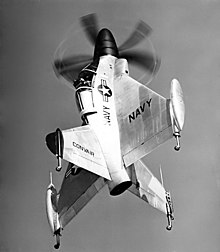Convair XFY-1
| Convair XFY-1 Pogo | |
|---|---|
 The XFY-1 in flight |
|
| Type: | Experimental airplane |
| Design country: | |
| Manufacturer: | |
| First flight: |
November 2, 1954 |
| Commissioning: |
Never put into service |
| Production time: |
Was never mass-produced |
| Number of pieces: |
1 |
The Convair XFY-1 Pogo was a rear-starter American aircraft developed in the 1950s . Originally developed as a prototype of an interceptor , the program was discontinued after about a year of flight testing and when rear starters were recognized as unsuitable.
history
In 1947 the US Navy and US Air Force started studies under the name "Project Hummingbird". The aim of the research was the concept of a VTOL -capable, compact interceptor that could be stationed on ships without having to rely on an aircraft carrier .
In 1950 the Navy officially tendered the development of an airworthy prototype, and in May 1951 Convair and Lockheed were each awarded a corresponding contract. Both machines were to use an Allison YT40 -A-6 turboprop engine with two counter-rotating Curtiss-Wright propellers . The name “Pogo” was officially only given to the Convair XFY-1; later, however, the term caught on for the XFY-1 and the Lockheed XFV-1 .
Convair relied on a compact design with delta wings . The rest of the tail consisted of two surfaces of the same size and shape above and below the fuselage . These ended flush with the wings; the landing gear consisted only of small rollers at the tips of the tail unit so that the machine could touch down on the stern. This improvised landing gear had no brakes, which is why a safe landing was only possible when there was no wind. For vertical flight, the pilot's seat could be turned 45 ° forward. An ejection seat should ensure safety . There was a rope in the cockpit in case the pilot ever had to land and disembark outside the airfield. The tail fin under the fuselage could be blown off in an emergency, for example if a "belly landing" was unavoidable.
After about a month of engine tests at Lindbergh Field (now San Diego International Airport ), the XFY-1 was moved in April 1954 to a former airship hangar at the Moffett Field naval air base near Sunnyvale (California) for testing in a sheltered environment to be able to perform. On April 29th the machine took off for the first time, secured by four ropes on the tail unit tips and one on the "nose". The front rope could be tensioned by a winch operated by a test engineer in order to bring the aircraft into a stable, vertical position in an emergency. The fact that the airflow of the XFY-1 was thrown back on the hangar walls and created strong turbulence was not foreseen, which is why the tests were canceled several times. Nevertheless, the testers completed over 60 hours of flight in the hangar.
On August 1, 1954, the first free hover flights took place over the outdoor area, whereupon the test series was relocated to Naval Auxiliary Air Station Brown Field near San Diego . Over 70 other vertical hover flights were carried out until the first transition followed on November 2, 1954, followed by a 21-minute level flight. On November 4th, another transition was completed during a presentation of the XFY-1.
A major problem was the aircraft's lack of stability at low speed, especially during the transition from level to hover and the subsequent landing. The downwash of the propeller (engl. Downwash ) caused strong turbulence close to the ground, the more difficult the landing addition. It was also problematic that the machine did not have any air brakes, which made it difficult to reduce speed, especially after fast flights and thus precise approaches to the landing field.
On May 19, 1955, another test pilot flew the XFY-1 for the first time, with no experience of this type, and only narrowly escaped an accident. The test facility was moved from the hangar on Moffett Field to Brown Field and training for more pilots began. However, when it became foreseeable that the engine needed a general overhaul and the Navy wanted to limit its support, the tests were ended. The last flight took place on June 16, 1955, the program was officially discontinued on August 1, 1956 by the Navy. The planned installation of the more powerful Allison YT40-A-14 engine was never carried out; however, this same engine with identical propellers was later used in the Hiller X-18 .
Until 1973 the machine graced the entrance of the Naval Air Station in Norfolk (Virginia) . They were then taken to the National Air and Space Museum in Washington, DC
Technical specifications
| Parameter | Data |
|---|---|
| crew | 1 |
| length | 10.66 m |
| span | 8.43 m |
| Wing area | 39.7 m² |
| height | 7.2 m |
| Propeller diameter | 4.8 m |
| Empty mass | 5,850 kg |
| Max. Takeoff mass | 7,371 kg |
| Top speed | 980 km / h (at an altitude of 4,570 m) |
| Marching speed | 640 km / h (at approx. 10,000 m altitude) |
| Service ceiling | k. A. |
| Range | k. A. |
| Engines | an Allison YT40 -A-6 turboprop with 4,362 kW |
Web links
- The history of the XFY-1 on the homepage of the National Air and Space Museum (English)


